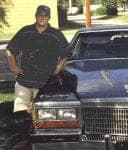
-----
How to strike plate steel in preparation for Acid Copper Plating
I am having a problem with the theory of "acid copper" plating. Supposedly copper in this technique cannot be plated onto steel, which I want to plate it onto, then the book I am getting this info from says that cyanide copper bath is needed, well cyanide gave me asthma, so by doctors orders I can't work with it. I am thinking maybe I should just give it a nice strong watts nickel plate then build up the copper and sand it to the desired appearance, then continue with the bright nickel, etc....
Any info on this subject will help immensely.
Yours Truly

Barrett Russell
Saskatoon, Saskatchewan, Canada
1999
Yes, nickel plating first should work. But do you think you should be plating at all if you've already had an asthma attack from it?

Ted Mooney, P.E.
Striving to live Aloha
finishing.com - Pine Beach, New Jersey
Ted is available for instant help
or longer-term assistance.
1999
What you need is a copper strike. Several years ago cyanide was all that was available. Now, you can buy a pyrophosphate based copper strike which works fairly well.
You can use a nickel strike on steel. This is not a "Watts" nickel, and certainly not a strong one. There are sulphate nickel strikes available, but a Woods strike is the preference of many if not most platers.
Either nickel strike is based on low metal content and strong acid so that you do not get an immersion plate, which normally has very poor adhesion.
James Watts- Navarre, Florida
1999
1999
oh sorry to not explain, I used to asthma, and it went away, but plating and on top of that painting cars, kinda brought it back, it isn't severe tho', it taught a good lesson not to take anything lightly, I think it helped a lot in that aspect, and wasn't all for the worse, thanks for your concern though.
Breathing better,

Barrett Russell
Saskatoon, Saskatchewan, Canada
You've got a good advise: copper strike with low-grade pyrophosphate solution.
Anton Cheglov1999
If your putting on heavy copper plate that must have a very strong adhesion to base material (like roll threads as a example) the best procedure other than cyanide copper flash was a very acidic watts nickel (not nickel strike) pH 1, and then a live entry system when going into the acid copper bath.
Chris Snyderplater - Charlotte, North Carolina
1999
At a pH of 1, it sounds like a strike to me. Normally a true strike would have a lower nickel content to go with it, but that is not mandatory. It will just plate slightly faster, but still extremely slow.
James Watts- Navarre, Florida
1999
Could you please explain me what the word STRIKE means if we talk about electroplating.
Thanks in advance.
Adam Wittmann- Poznan, Poland
1999
In this context, 'strike' means a plating solution which has a very low concentration of metal in it and which is therefore less prone to immersion deposit than a standard solution.

Ted Mooney, P.E.
Striving to live Aloha
finishing.com - Pine Beach, New Jersey
Ted is available for instant help
or longer-term assistance.
1999
Q, A, or Comment on THIS thread -or- Start a NEW Thread